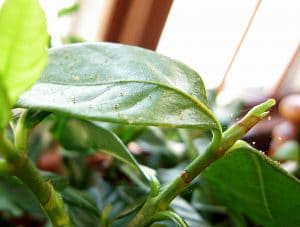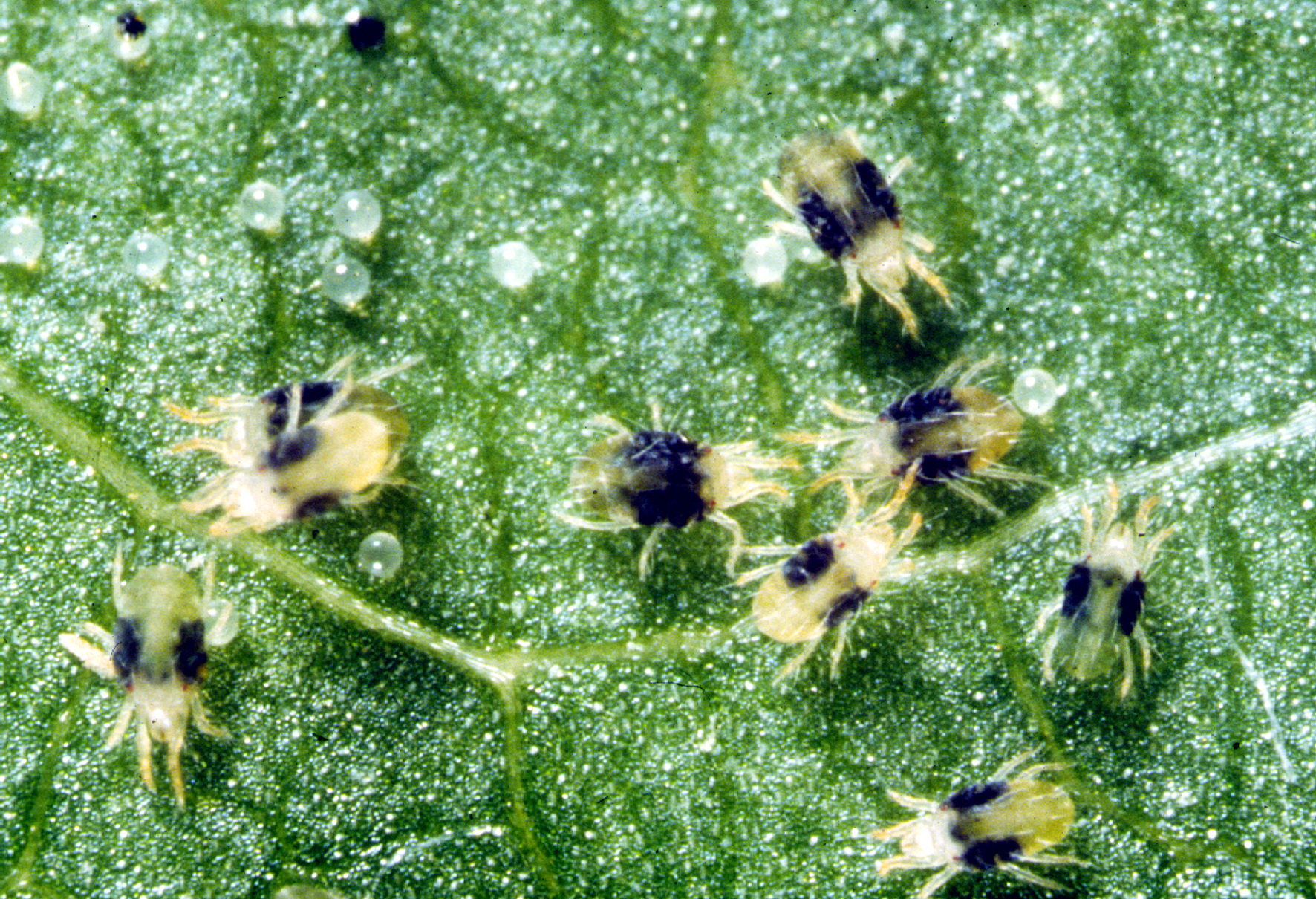What insecticide should you use for spider mites?
The best insecticides to use on spider mites are:
- Safer Brand 5118 Insect Killing Soap
- Garden Safe Insecticidal Soap Insect Killer
- Bayer Advanced 701290 3-in-1 Insect Disease and Mite Controle
- Voluntary Purchasing Group 32034 Paraffin Oil Spray
- Mite Massacre 8 Oz. spider mite killer and powdery mildew fighter
- Growes Trust Spider Mite Killer, Non-toxic
- Smite spider mite killer (organic)
- Spinosad (organic)
- Neem oil pesticides
- Bondie-All season Horticultural & Dormant Spray Oil (repellent)
A general note of caution, you should know that they tend to adapt effective resistances to pesticides. Prolonged uses of the same substances will make them come back, eventually.
Let’s look at the signs of spider mites in order to be sure that spider mites are affecting your plants and not something else.
Then we will look at how to apply pesticides but also consider some other methods to get rid of them.
Signs and symptoms of spider mites damage to plants, flowers, leaves, etc
The way they work is that they latch on a plant in hard to spot colonies and begin to feed, by drilling through the leaves/body of the plant and sucking its juices (chlorophyll, sap, etc).

This will eventually result in them having a speckled and mottled appearance. Shortly after, the color of the plant changes into a sickly and white-ish yellow, followed by it drying up and dying.
In order to identify a mite infestation, paying very close attention to the following ”markers”:
First, check for asymmetrical webs. They get their name from the fact that most spider mite species lay their -transparent- eggs on silk webbing, which aids with protecting their offspring from predators.
At first, you might believe that those are spider webs. They are not, as real spider webs have a silky, luscious hue and are symmetrical. Mite webs are more dense, hairy and unclean in texture and cover asymmetrical surfaces.
Second, see if the leaves bear any holes in them, as individual colonies tend to chew them in an unorganized fashion.
Then, check the color of the leaves/plant and see if they tend towards a white-ish yellow hue. By the time where most of the plant is colored like this, or even worse, dry, it might be too late.
And you should be able to easily assess this since you should be knowledgeable about how often you water the plants.
Finally, take a close look and see if there is a blob of tiny, dot sized, things that are all clumped together near those holes on the leaves or of the body. If so, then, unfortunately, you have a spider mite infestation.
Alternatively, take a sheet of white paper and tap a suspected leaf. Then, pay close attention to any movement.
How to control spider mites indoors and outdoors
The best measure one could adopt in order to prevent a spider mite infestation is, actually, prevention and quarantine.
If we are talking about in-door or out-door plants in mobile pots, your best option would be to isolate them from other healthy plants. Afterward, try to apply any matter of pesticide, be it natural or artificial, to the plant and see if it works. If not, the plant might be done for.
However, the big issue comes with stationary plants and especially with orchards and crops. Despite all of the aforementioned doom and gloom, it is not impossible to contain an infestation. A first, rudimentary step in preventing them, is to clean the plants when you water them.
Sure, it takes a lot of time, but it is necessary. You should do this at least once a week. High-pressure hoses work incredibly well, but manual cleaning is also possible.
Always remember to focus on the underside of the leaves and hidden crevices, since there is where they usually congregate.
Here is a video on how to identify and get rid of spider mites:
Are there any homemade spider mite killers?
Unfortunately, there are not many homemade killers. However, here are a couple of homemade alternatives to pesticides.
Good homemade mite killers are made from the extracted essences of plants. The most popular ones are garlic, thyme, cinnamon, clover, and rosemary, as their oils make for powerful natural insecticides.
Another way is to spray your plants with near-freezing water each morning. Freezing temperatures simply kill the mites. It will not be fully efficient but expect 30-50% fewer numbers.
Spider mite predators
Fortunately for you, spider mites have many natural predators. However, they highly depend on climate, humidity, species of vegetation, etc.
Ironically, their greatest predators are other mites, but of the ”predatory” variant, such as the Galendromus occidentalis, which are actually bred and sold specifically to combat the spider mites.
They do not feed on plants and do not become pests, thus being the best anti-body measure. If you intend to use this method, clean the plants first, as you want your predatory mites to have as little opposition as possible.
Ratio
A good ratio for the predatory mites is 1 per 8-10 spider mites. Thus, try and approximate how many blobs there are and tell your seller their size and number, as you do not want to fall short, nor in excess. After application, they will solve the problem by themselves, granted you do not kill them with pesticides. And they should last indefinitely, allowing you to skip pesticides when dealing with mites.
Unfortunately, they do not work on other pests, so be careful about how you juggle everything. If there are multiple pest species, pesticides are better. If there are only mites, go for the predatory mites.
How many?
As for numbers, those are some good references:
- For tomatoes and cucumbers, 10 predators per plant plus 1-2 per infested leaf
- For other greenhouse crops, tropical plants, and outdoor gardens, 2,000 per 3,000 square feet
- For bedding plants, 4,000-8,000 per 5,000 square feet
- For large agri-business, 25,000 – 50,000 per acre depending on infestation
Check them on Amazon, here.
Another natural predator is the ladybug. Their story is basically similar to the predatory mites, so I will not repeat the same information.
All that you will need to do with them is to irrigate the plants to give them a fresh source of water. Release them, preferably at dusk, and let the magic happen on its own. Also, release them in small, regular waves, rather than all at once. If you applied pesticides, wait for several weeks, as to not kill them.
Check them on Amazon, here.
What are spider mites and where do they come from?

Spider mites are quite an oddity, as they are considered to be both pests and a type of the arachnid family, being related to spiders, scorpions, and ticks, while also not being considered to be insects.
They are incredibly small, being less than 0.04 inches (1mm), similar in size as a digital dot, akin to the one at the end of this sentence. And those are only the mature mites, as their offspring are even smaller.
They can generally -and widely- be found within gardens, yards, greenhouses, orchards, crops and even within indoor growing environments. They feed on basically anything plant-based, starting from grass and going to fruits, vegetables, crops, and even trees.
Appearance-wise, they generally range in colors between pale yellow, reddish hues, green and browns. The most common of them all is the two-spotted spider mite, which sports dark spots on both sides of its body.
Next to it are the less common Tumid, Pacific, Spruce, and Southern red mite. For more info on the various species of mites, check this link.
How do they enter the house?
They enter your house by simply latching to the plants that they infest. They are, when inactive, almost impossible to spot until it is too late. The best way to avoid this is to quarantine any plant you take inside for a few months and see how it fares.
What environmental conditions do they prefer
Spider mites love hot and dry climates. Although they can prosper through temperatures as low as 57 degrees Fahrenheit or 14 degrees Celsius, higher ones starting from 75 degrees Fahrenheit or 24 degrees Celsius are ideal. Also, they usually have a strong grip on regions where the humidity levels are equal and below 60%.
Spider mites usually tend to explode in numbers in areas with high levels of nitrogen, carbohydrates and phosphorous substances. This translates into huge numbers of them swarming around field crops that are irrigated on a commercial scale.
However, they can easily be found in your own house as well as on the leaves of a corn crop, especially if you irrigate your garden through a sprinkler irrigation system. The overly-fertilized plants, in particular, are especially attractive to female mites, since they contain higher levels of protein and amino acids, which is a great food source.
For example, let’s say that there is a large field of corn in California, at the start of the harvest season (late September). The crop was also sprinkled with a cocktail of water and added nutrients throughout its growing cycle.
This is a perfect combination of conditions required by mites to simply explode in numbers, as in those conditions, a laid egg could hatch in as little as 3 days.
Their average life cycle from egg to adult is of about 14 days in temperate/humid climates, with shorter 7-10 days periods in hot and dry environments, with a life-span of 2-4 weeks. And they require as little as 5 days in order to become sexually mature, with a female being able to lay up to 20 eggs per mating cycle.
